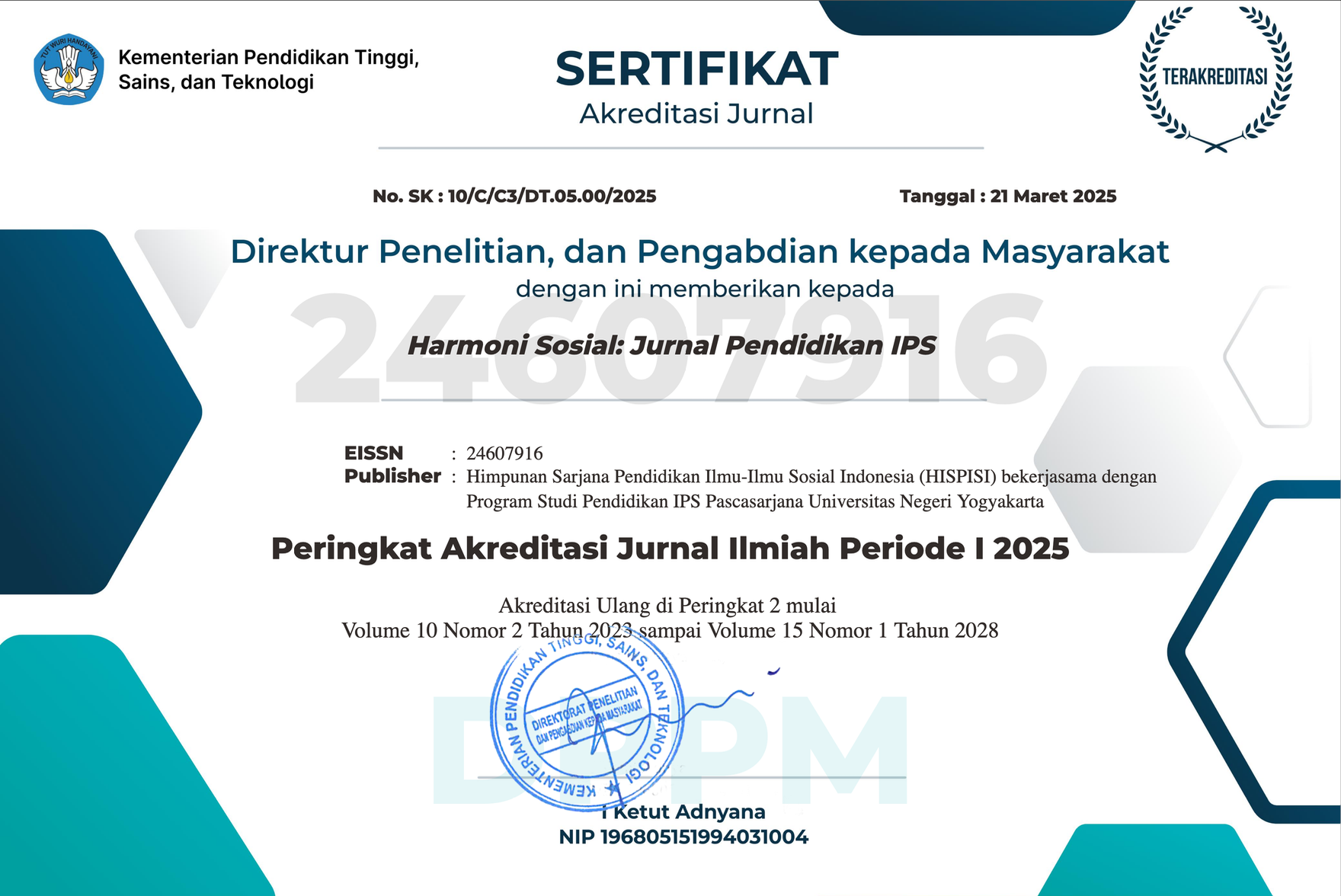Sufism and social cohesion: The role of Hizib Nahdlatul Wathan Tariqa in pluralistic religious life in East Lombok
Downloads
Tariqa, within the framework of Sufism, refers to a system of religious thought and practice cultivated and exemplified by adherents of Sufi orders (tarekat) who embody a pluralistic orientation. This study seeks to elucidate the evolution of a diversity-orientated mentality embedded in tariqa (tasawuf) practices in East Lombok during the New Order era. Employing a historical research approach, this study adopts the established stages of historical inquiry is heuristics, source criticism, interpretation, and historiography. The findings indicate that the development of tariqa in East Lombok constitutes a long-standing historical process, rooted in the introduction of Islam to the region in the 15th and 16th centuries. This development has been consistently preserved as an integral element of the religious fabric of East Lombok society. The mentality of diversity has been culturally nurtured through a sustained and profound relationship between spiritual teachers (murshid) and their disciples within tarekat institutions. During the New Order period, the transformation of tariqa adherents into a community committed to fostering a culture of inclusivity and social cohesion was notably evident. Remarkably, the region experienced no communal conflict throughout the era, contributing to the formation of a harmonious society. This study aspires to contribute meaningfully to scholarly discourse on tariqa practices that embody tolerance and serve as exemplary models within pluralistic societies.
Downloads
Ahmad, M., Aziz, A., Afad, M. N., Muniroh, S. M., & Qodim, H. (2021). The Sufi order against religious radicalism in Indonesia. HTS Teologiese Studies / Theological Studies, 77(4). https://doi.org/10.4102/hts.v77i4.6417
Alfarisi, S., Tohri, A., Habibuddin, & Hanapi. (2018). Tuan Guru: Gerakan Revolusi Sosial Masyarakat Sasak. Lombok Institut, Pemerintah Daerah Lombok Timur, Kalam Semesta.
Alfarisi, S., Tohri, A., Hadi, Z., Habibuddin, Hanapi, & Rasyad, A. (2016). Tuan Guru Umar Kelayu: Poros Lombok Makkah-Nusantara. Lombok Institut, Pemerintah Daerah Lombok Timur, Kalam Semesta.
Aljunied, K. (2025). Contemplating Sufism: Dialogue and Tradition Across Southeast Asia. John Wiley & Sons. https://doi.org/10.1002/9781394270484
Azis, A., Pabbajah, M., & Pabbajah, M. T. H. (2024). The Authority of Khalwatiyah Tariqa of Sheikh Yusuf Al-Makassary on Fostering Religious Moderation in South Sulawesi. International Journal of Islamic Thought, 25. https://doi.org/10.24035/ijit.25.2024.282
Bartholomew, J. R. (2001). Alif Lam Mim: Kearipan Masyarakat Sasak (Terjemahan Imran Rosyidi). Tiara Wacana.
Basarudin. (2019). Sejarah Perkembangan Islam di Pulau Lombok pada Abad Ke-17. SANGKéP: Jurnal Kajian Sosial Keagamaan, 2(1), 31–44. https://doi.org/10.20414/sangkep.v2i1.933
Biyanto. (2017). The Typology of Muhammadiyah Sufism: Tracing its Figures' Thoughts and Exemplary Lives. Indonesian Journal of Islam and Muslim Societies, 7(2), 221–249. https://doi.org/10.18326/ijims.v7i2.221-249
Bruinessen, M. Van. (2000). Shaykh `Abd al-Qadir al-Jilani and the Qadiriyya in Indonesia. Journal of the History of Sufism, 1–2, 361–395.
Budiwanti, E., & Eidhamar, L. G. (2024). Religious Diversity in Lombok: Peaceful Coexistence or Minorities at Risk? Religions, 15(12), 1544. https://doi.org/10.3390/rel15121544
Dahri, H. (2010). Reposisi Tarekat Hizib NW dalam Tarekat Mu’tabarah di Indonesia. Penamadani.
Fahmi, M. I., Anam, A. M., Wiratmoko, D., Yaacob, N. H., & Alwiyah, N. (2025). Positivism and Ibn Khaldun's thought: bridging objectivity and social dynamics. Harmoni Sosial: Jurnal Pendidikan IPS (HSJPI), 12(1), 26–36. https://doi.org/10.21831/hsjpi.v12i1.83847
Fahrurrozi. (2018). Tuan Guru and Social Change in Lombok, Indonesia. Indonesia and the Malay World, 46(135), 117–134. https://doi.org/10.1080/13639811.2018.1452487
Faisol, L. S., & Sa’i, M. (2005). Kontribusi Tarekat Qadiriyah wa Naqsabandiyah dalam Dakwah Islamiyah di Lombok. Jurnal Penelitian Keislaman, 1(2), 1–22.
Fattah, A., Quddus, A., Jamaluddin, & Muslim, M. (2017). Dari Nahdlatul Wathan untuk Indonesia: Perjuangan TGKH. Muhammad Zainuddin Abdul Madjid (1908-1997). Dinas Sosial NTB.
Febrianti, N., Abubakar, & Husni, M. (2019). Eksistensi Tarekat Junaidi Al-Baghdadi Terhadap Pembinaan Masyarakat Islam di Majelis Darul Ikhlas Kota Palangka Raya. Jurnal Studi Agama Dan Masyarakat, 15(2), 118–132. https://doi.org/10.23971/jsam.v15i2.1622
Giddens, A. (2009). Problematika Utama dalam Teori Sosial; Aksi, Struktur, dan Kontradiksi dalam Analisis Sosial (Terjemahan oleh Dariyatno). Pustaka Pelajar.
Giddens, A. (2010). Teori Strukturasi: Dasar-dasar Pembentukan Struktur Sosial Masyarakat. Pustaka Pelajar.
Hamdie, I. M. (2019). Jejak-jejak Pluralisme Agama dalam Sufisme. Khazanah: Jurnal Studi Islam Dan Humaniora, 17(2), 263–282. http://dx.doi.org/10.18592/khazanah.v17i2.3207
Harnish, D. (2021). Tolerance of Ambiguity: Negotiating Religion and Sustaining the Lingsar Festival and Its Performing Arts in Lombok, Indonesia. Religions, 12(8). https://doi.org/10.3390/rel12080626
Hasjmy, A. (1993). Sejarah Masuk dan Berkembangnya Islam di Indonesia. Al-Ma’arif.
Hidayat, Z., & Syahrul, M. (2017). Indonesian Sufi in Malay world: a preliminary exploration with reference to Tariqa Naqshabandiyya-Kahlidiyya Babussalam (TNKB). Journal of Indonesian Islam, 11`(1), 201–222. https://doi.org/10.15642/JIIS.2017.11.1.201-222
Irawan, S. I., & Nurjannah, S. (2016). Tasawuf Nusantara: Studi Tarekat Hizib Nahdlatul Wathan. Jurnal Yaqzhan: Analisis Filsafat, Agama Dan Kemanusiaan, 2(2), 216–236. https://doi.org/10.24235/jy.v2i2.1290
Ismail, F. (2011). THE NAHDLATUL ULAMA: Its Early History and Contribution to the Establishment of Indonesian State. JOURNAL OF INDONESIAN ISLAM, 5(2), 247. https://doi.org/10.15642/JIIS.2011.5.2.247-282
Khotimah, K., & Sukron, M. (2023). The realising of religion moderation in Tareqa Al-Yusriyyah As-Siddiqiyyah Ash-Shadhiliyyah. HTS Teologiese Studies / Theological Studies, 79(1), 1–9. https://doi.org/10.4102/HTS.V79I1.7964
Kuntowijoyo. (2015). Penjelasan Sejarah (Historical Explanation). Tiara Wacana.
Lindsey, T., & Steiner, K. (2025). Islam, law and the state in the Philippines. Routledge. https://doi.org/10.4324/9781003536598
Madjid, M. Z. A. (1964). Tarekat Hizib Nahdlatul Wathan dan Hizib Nahdlatul Banat. Pengurus Besar Nahdlatul Wathan.
Mufid, A. S. (2006). Tangklukan, Abangan, dan Tarekat Kebangkitan Agama di Jawa. Yayasan Obor Indonesia.
Mutawali. (2016). Moderate Islam in Lombok The Dialectic Between Islam and Local Culture. Journal of Indonesian Islam, 10(2), 309–334. https://doi.org/10.15642/JIIS.2016.10.2.309-334
Muttaqin, A., Hamsah, U., & Abror, R. H. (2023). Muhammadiyah, Sufism, and the quest for 'authentic' Islamic spirituality. Indonesian Journal of Islam and Muslim Societies, 13(1), 199–226. https://doi.org/10.18326/ijims.v13i1.199-226
Muzayyin, A. (2020). Tarekat dan Perempuan di Lombok: Analisis Peran Mursyid Perempuan dalam Tarekat Hizib Nahdlatul Wathan. Universitas Islam Negeri Raden Fatah Palembang.
Nahdi, K. (2013). Dinamika Pesantren Nahdlatul Wathan dalam Perspektif Pendidikan, Sosial, dan Modal. Islamica, 7(2), 381–405. https://doi.org/10.15642/islamica.2013.7.2.381-405
Ni'am, S., & Nurhayati, A. (2019). Tasawuf Kebhinnekaan (The Sufism of Diversity) according to The Perspective of Indonesian Sufis: A Response toward the Problem of Diversity. International Journal of Philosophy and Theology, 7(2), 1–19. https://doi.org/https://doi.org/10.15640/ijpt.v7n2p1
Nurwendah, Y. D., Kailani, N., & Udasmoro, W. (2024). Religious Soundscape, Sacred Space, and Affective Body: The Experience of Sufi Whirling Ritual Practitioners in Java. Teosofi: Jurnal Tasawuf Dan Pemikiran Islam, 14(1), 145–162. https://doi.org/10.15642/teosofi.2024.14.1.145-162
Quddus, A. (2020). The Book of Ṣirāṭ al-Mustaqīm by Nūr al-Dīn al-Rānirī and the Development of Taṣawwuf in Lombok. Ulumuna, 23(2), 402–424. https://doi.org/10.20414/ujis.v23i2.380
Rasyad, A., Dienaputra, R. D., Zakaria, M. M., & Mulyadi, R. M. (2021). Tarekat dan Modal Sosial dalam Sistem Pendidikan Nahdlatul Wathan, 1966-1997. Jurnal Sejarah Citra Lekha, 6(2), 68–79. https://doi.org/10.14710/jscl.v6i2.31812
Ricklefs, M. C. (2008). Sejarah Indonesia Modern 1200-2008. Serambi.
Robinson, F. (2008). Islamic Reform and Modernities in South Asia. Modern Asian Studies, 42(2–3), 259–281. https://doi.org/10.1017/S0026749X07002922
Rusli, R., & Yanto. (2018). Relevansi dan Kontinuitas Pemikiran Islam Klasik dalam Intelektualisme Islam Melayu Nusantara. Wawasan: Jurnal Ilmiah Agama Dan Sosial Budaya, 3(2), 187–197. https://doi.org/10.15575/jw.v3i2.3582
Saepudin, D. (2006). Proses Islamisasi Penduduk Indonesia dalam Perspektif Sejarah. Jurnal Mimbar Agama Budaya, 23(3), 219–234.
Sarr, E. (2019). The Role of Neo-Sufism and the Ritual Phenomenon of Slawatan in Promoting Religious Tolerance. International Journal of Interreligious and Intercultural Studies, 2(1), 103–118. https://doi.org/10.32795/ijiis.vol2.iss1.2019.316
Sevea, T. (2023). Keramat: Muḥammad's Heirs and Nodes of a Multi-Centered Islam in Southeast Asia. International Journal of Islam in Asia, 4(1–2), 48–74. https://doi.org/10.1163/25899996-20241068
Smith, B. J. (2021). Sufism and the sacred feminine in Lombok, Indonesia: Situating spirit queen dewi anjani and female saints in Nahdlatul Wathan. Religions, 12(8), 563. https://doi.org/10.3390/rel12080563
Smith, B. J., Hamdi, S., & Muzayyin, A. (2023). Female Sufi guides and the Murshida fatwa in Indonesian Sufism: Murshidas in a Sufi order in Lombok. Contemporary Islam, 17(3), 363–390. https://doi.org/10.1007/s11562-023-00522-z
Sukarnawadi, A. A. (2015). Selayang Pandang Tarekat Hizib Nahdlatul Wathan. Diakses 2 Desember 2019. https://www.aziznawadi.net/selayang-pandang-tarekat-hizib-nahdlatul-wathan/
Suprapto. (2017). SASAK MUSLIMS AND INTERRELIGIOUS HARMONY: Ethnographic Study of the Perang Topat Festival in Lombok-Indonesia. Journal of Indonesian Islam, 11(1), 77–98. https://doi.org/10.15642/JIIS.2017.11.1.77-98
Suprapto, & Huda, M. (2020). Religiositas di Tengah Bencana Gempa Bumi Lombok-Indonesia. Religious: Jurnal Studi Agama-Agama Dan Lintas Budaya, 4(2), 93–102. https://doi.org/https://doi.org/10.15575/rjsalb.v4i2.8598
Suprapto, S., & Huda, M. (2023). Religious Commodification: Muslim Housing and Identity Affirmation in Lombok, Indonesia. Studia Islamika, 30(1), 97–127. https://doi.org/10.36712/sdi.v30i1.23818
Syukur, A. (2014). Transformasi Gerakan Tarekat Syafawiyah dari Teologis ke Politis. KALAM, 8(1), 187–212. https://doi.org/10.24042/klm.v8i1.189
Tohri, A., Habibuddin, & Rasyad, A. (2020). Sasak People's Resistance Against Mataram-Karangasem and Dutch Colonial Rulers: The Role of Tuan Guru Umar Kelayu. Journal of Asian Social Science Research, 2(1), 73–90. https://doi.org/https://doi.org/10.15575/jassr.v2i1.13
Tohri, A., Rasyad, A., Habibuddin, H., & Zulkarnain, Z. (2022). Tauhid View Tuan Guru Umar Kelayu: Intellectual History Study of Lombok Theologian Central Figure. Paramita: Historical Studies Journal, 32(1), 1–10. https://doi.org/10.15294/paramita.v32i1.26636
Ubaedillah, A. (2015). Sufi Islam and the nation state: Darul Arkam movement in the post Suharto era of Indonesia. Indonesian Journal of Islam and Muslim Societies, 5(1), 79. https://doi.org/10.18326/ijims.v5i1.79-110
van Bruinessen, M. (1992a). Tarekat dan Politik: Amalan untuk Dunia atau Akherat? Majalah Pesantren, 9(1), 3–14. https://sites.google.com/site/nimusinstitut/tarekat-dan-politik
van Bruinessen, M. (1992b). Tarekat Naqsabandiyah di Indonesia: Survei Historis, Geografis dan Sosiologis. Mizan.
van Bruinessen, M. (1994). The Origins and Development of Sufi Orders (Tarekat) in Southeast Asia. Studia Islamika, 1(1), 1–23. https://doi.org/10.15408/sdi.v1i1.864
Wijaya, H. (2024). Religious and National Dialogue in Hamzanwadi's Wasiat Renungan Massa: A Hermenutical Perspective. Research Journal in Advanced Humanities, 5(1), 374–400. https://doi.org/10.58256/svt5ph36
Wijaya, H., Andayani, A., & Wardani, N. E. (2025). Reinterpretation of religious and nationalism in Wasiat Renungan Masa: A hermeneutical approach to Hamzanwadi's thought. Studies in English Language and Education, 12(2), 1023–1038. https://doi.org/10.24815/siele.v12i2.37491
Wijaya, H., Fakihuddin, L., Ernawati, T., & H.A. Gani, R. (2024). Symbolic and Philosophical Meanings of Religion and Politics in Hamzanwadi's Wasiat Renungan Masa Pengalaman Baru: A Semiotic Perspective. Wawasan: Jurnal Ilmiah Agama Dan Sosial Budaya, 9(2), 77–92. https://doi.org/10.15575/jw.v9i2.36476
Winoto, D. E., Dasfordate, A., Pelealu, A. E., Burdam, Y., Ramaino, A. S., & Dasfordate, G. (2023). Depth-social interaction between ethnic in the local culture of Minahasa. Harmoni Sosial: Jurnal Pendidikan IPS (HSJPI, 10(1), 75–89. https://doi.org/10.21831/hsjpi.v10i1.54492
Ziadi, M. R. (2018a). TAREKAT DAN POLITIK: Studi Living Sufism Tarekat Hizib Nahdlatul Wathan. Living Islam: Journal of Islamic Discourses, 1(2), 231–271. https://doi.org/10.14421/lijid.v1i2.1613
Ziadi, M. R. (2018b). Tarekat Hizib Nahdlatul Wathan dan Perannya dalam Perpolitikan di Lombok. Refleksi: Jurnal Filsafat Dan Pemikiran Islam, 18(2), 207–239. https://doi.org/10.14421/ref.2018.1802-05

This work is licensed under a Creative Commons Attribution-ShareAlike 4.0 International License.
The Authors submitting a manuscript do so on the understanding that if accepted for publication, copyright publishing of the article shall be assigned to Harmoni Sosial: Jurnal Pendidikan IPS
 | Harmoni Sosial: Jurnal Pendidikan IPS by http://journal.uny.ac.id/index.php/hsjpi is licensed under a Creative Commons Attribution-ShareAlike 4.0 International License. |









 ISSN Print
ISSN Print









